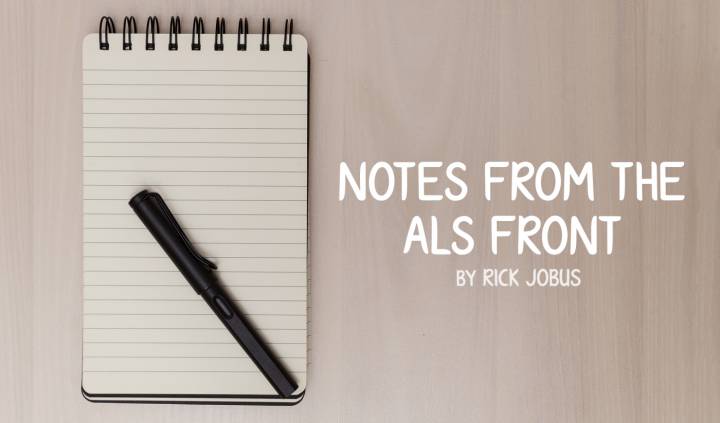ALS Awareness: What It’s Worth

“I think it’s time we stop, children, what’s that sound? Everybody look what’s going down.”
That call for awareness comes from the song “For What It’s Worth” by Buffalo Springfield. The song’s writer, Stephen Stills, penned the lyrics in response to the Sunset Strip curfew riots of 1966. Although it remains evocative of the era’s spirit and its tensions, it did not prescribe any consequential action.
Benign awareness has an analogous effect to that of a minor paper cut. It’s noticed, passes quickly, is forgotten, and causes no change. The trick is to impart actionable awareness. In my case, that has proven easier said than done.
Take my pre-ALS awareness of ALS, for example. As a fervent baseball fan from early childhood, I was introduced to Lou Gehrig’s disease as a youth of 7, through a viewing of the film “The Pride of the Yankees,” starring Gary Cooper. At that tender age, death was a frightening, albeit abstract concept. But to lose, as Gehrig did, the ability to do what you loved, and were exceptionally gifted at, was an even more horrific notion.
In the ensuing years, I occasionally would be reminded of the devastation that ALS is. The loss of jazz bassist, pianist, and composer Charles Mingus in 1979 saddened me. As did the passing of Baseball Hall of Fame pitcher James Augustus “Catfish” Hunter and golf caddie Bruce Edwards, in 1999 and 2004, respectively. I read the book “A Brief History of Time“ twice, semi-appreciative of what Stephen Hawking must have had to overcome to author it. I was aware, and became momentarily sympathetic, but did nothing.
Similarly, I had “injurious auto accident passerby reaction” to a host of tales of collective plight. I would grimace at the imagery, then fixate and mourn as the visual grew steadily smaller in my mental rearview mirror, and be hopeful that my journey would not be darkened by other grief-producing interruptions.
Even when prompted by an accompanying innocuous method to assist, I would typically remain inert. For the many noble causes soliciting aid in an emotionally charged pitch, my default position was to eschew the 63 cents per day, or $19 per month, plea.
However, that isolationist tendency would be reversed the moment someone I personally knew informed me of their tribulation. In that case, all forms of activism would be on the table.
My experience post-ALS confirms that to be a phenomenon visited upon many. Folks who know me have contributed nearly $40,000 on my behalf to ALS-related campaigns. Likewise, when asked, many have joined me in requesting systemic change via petition endorsement or direct mail correspondence.
That speaks to the importance of each of us — patient, family member, caregiver, and friend alike — broadcasting the maddening ordeal that ALS is. A first step in that direction is participation in the I Am ALS initiative, which seeks to open eyes to this calamitous disease, in every congressional district in the United States.
Beyond that, at a grassroots level, impactful ALS awareness can best be germinated via frank and substantive dialogue. The more people that are current with the havoc that ALS has wrought, the utterly hopeless outlook that exists today, and the abject institutional failure to provide help, the more allies we have. Allies not only for the month of May and the periodic fundraiser, but also for whenever the ALS court of human decency is convened.
Toward that end, in response to the obligatory “How are you?” query, I never hesitate to objectively share my present state of dysfunction, my struggles, my pains, and my fears. I am also known to point out how Medicare has shortchanged me, and the sheer lunacy of the regulatory approval process as it pertains to ALS therapies.
The sincere desire and a poised offer to help are what I seek in response to my story. For the day will come when an obviously efficacious treatment is identified in early-stage testing. If we factor in best-case historic elapsed time parameters for FDA approval, manufacturing startup, supply chain infiltration, and insurability resolution, then thousands — perhaps tens of thousands — of people will die with relief cruelly on the horizon.
But as COVID-19 has shown, extraordinary times can call for extraordinary measures. A potent variation of “Operation Warp Speed” would fit that bill. A strident outcry from a bipartisan constituency, driven by fervent, activated ALS awareness, might be exactly what it takes to launch such an endeavor.
A cure for ALS — now that would be a “For What It’s Worth” awareness example for the ages.
***
Note: ALS News Today is strictly a news and information website about the disease. It does not provide medical advice, diagnosis, or treatment. This content is not intended to be a substitute for professional medical advice, diagnosis, or treatment. Always seek the advice of your physician or other qualified health provider with any questions you may have regarding a medical condition. Never disregard professional medical advice or delay in seeking it because of something you have read on this website. The opinions expressed in this column are not those of ALS News Today or its parent company, Bionews Services, and are intended to spark discussion about issues pertaining to ALS.







Robert Ferson
Covid-19 is saturating the media right now. When that eases, cancer ads hammer into us that awareness. Yes most any cancer is a horrible thing, but there are treatments and even cures available because cancer have been and are ever present. How often do we see anything in the media about ALS? It's almost unheard of near where I live. Television, newspapers, flyers?...Nope! I have magnetic signs for my van. I'll bet that's the majority of awareness efforts in my county.